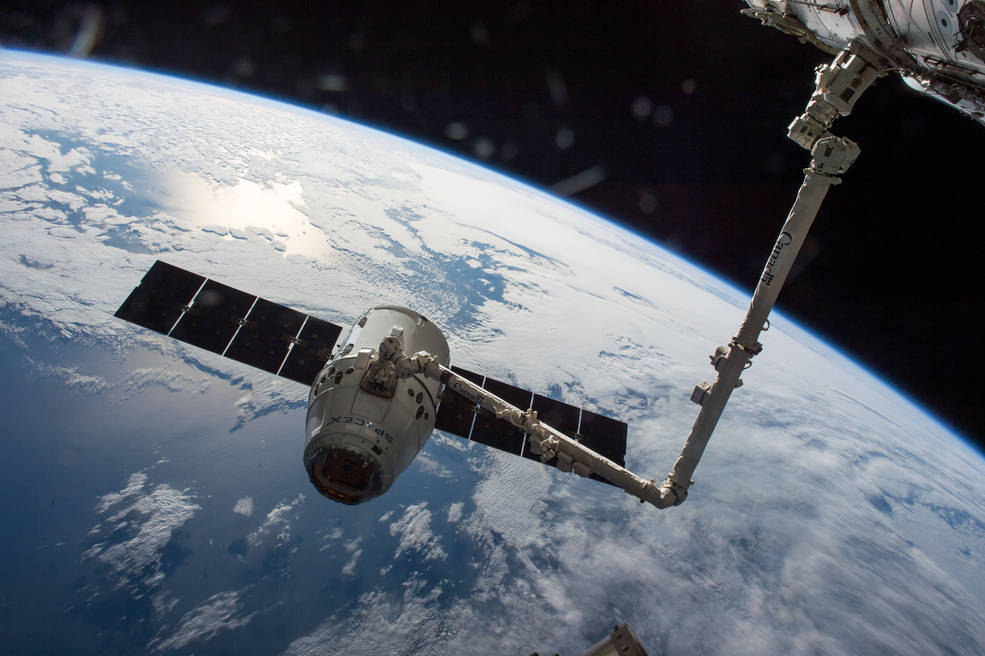
The SpaceX Dragon cargo spaceship is grappled by the International Space Station’s Canadarm2. The spacecraft delivered about 7,000 pounds of science and research investigations on April 10, including the Bigelow Expandable Activity Module (BEAM). Credits: NASA
The SSEP Mission 7 to ISS flight experiments payload Odyssey II was launched on April 8, 2016, at 4:43 pm EDT from Cape Canaveral Air Force Station, FL, aboard SpaceX CRS-8. The Dragon spacecraft was captured at ISS at 7:23 am EDT, April 10, 2016.
On-orbit flight operations for the 25 experiments comprising Odyssey II were conducted on the 5 pre-scheduled Crew Interaction Days by Flight Engineer astronauts Timothy Peake (ESA; Twitter @astro_timpeake) and Jeff Williams (USA; Twitter @Astro_Jeff, Instragram @astro_jeffw, Facebook NASA Astronaut Jeff Williams). All 25 student flight teams have been simultaneously conducting their ground control experiments using the SSEP Mission 7 to ISS: Experiment Log page.
After a month aboard ISS, Odyssey II is scheduled to depart Station on Dragon at 9:18 am EDT, May 11, 2016, with Tim Peake operating the robotic arm for vehicle separation. At 2:00 pm EDT, Dragon will execute a de-orbit burn, with splashdown in the Pacific at roughly 2:55 pm EDT. Live coverage of Dragon separation will begin on NASA TV at 9:00 am EDT, and you can watch it live in the NASA TV portal below. Also below is the NASA Media Advisory on Dragon’s departure from Station. Note that de-orbit and splashdown will not be covered live.
To all the Mission 7 student flight teams and communities, we’re all very proud of the job you’ve done. Despite the loss of Odyssey I last June with the destruction of SpaceX CRS-7 just 2.5 minutes after launch, everyone stepped to the plate, and we’re now about to get the re-flight experiments back from Low Earth Orbit. I’ll say it again … failure happens. What we do in the face of failure defines who we are. Who are these student researchers? They are America’s next generation of scientists and engineers.
All teams should now be standing by for Dragon recovery, payload de-integration at Johnson Space Center by NanoRacks, and FedEx overnighting of the M7 experiments back to teams for harvesting and analysis.
WATCH LIVE ON THIS NASA TV PORTAL
http://www.nasa.gov/multimedia/nasatv/#.Ux37dCjn1sQ
May 05, 2016
MEDIA ADVISORY M16-052
NASA TV to Broadcast Dragon Departure from International Space Station
After delivering almost 7,000 pounds of cargo to the International Space Station, including the Bigelow Expandable Activity Module (BEAM), the SpaceX Dragon cargo spacecraft is set to leave the orbital laboratory with valuable science research and return to Earth on Wednesday, May 11. NASA Television will provide live coverage of Dragon’s departure beginning at 9 a.m. EDT.
The Dragon spacecraft, which arrived at the station April 10, will be detached from the Earth-facing side of the station’s Harmony module using the Canadarm2 robotic arm, operated by ground controllers at NASA’s Johnson Space Center in Houston. Robotics controllers will maneuver Dragon into place and Expedition 47 robotic arm operator Tim Peake of ESA (European Space Agency) will execute the command for its 9:18 a.m. release.
Dragon will fire its thrusters three times to move to a safe distance from the station before being commanded to begin its deorbit burn about 2 p.m. The capsule will splash down in the Pacific Ocean about 2:55 p.m. The deorbit burn and splashdown will not be broadcast on NASA TV.
A recovery team will retrieve the capsule and its more than 3,700 pounds of return cargo, including samples from ongoing space station research, which ultimately will be shipped to laboratories for further study. This cargo includes samples from human research, biology and biotechnology studies, physical science investigations and education activities sponsored by NASA and the Center for the Advancement of Science in Space (CASIS), the nonprofit organization that manages research aboard the U.S. national laboratory portion of the space station. The spacecraft also will return the final batch of human research samples from the one-year crew mission.
In the event of adverse weather conditions in the Pacific, the backup departure and splashdown date is Saturday, May 14.
Dragon, the only space station resupply spacecraft able to return to Earth intact, launched April 8 on a SpaceX Falcon 9 rocket from Cape Canaveral Air Force Station in Florida, for the company’s eighth NASA-contracted commercial resupply mission to the station.
For NASA TV scheduling and video streaming information, visit:
For more information about the International Space Station, its research and crews, visit:
-end-
The Student Spaceflight Experiments Program (SSEP) is a program of the National Center for Earth and Space Science Education (NCESSE) in the U.S., and the Arthur C. Clarke Institute for Space Education internationally. It is enabled through a strategic partnership with NanoRacks LLC, working with NASA under a Space Act Agreement as part of the utilization of the International Space Station as a National Laboratory. SSEP is the first pre-college STEM education program that is both a U.S. national initiative and implemented as an on-orbit commercial space venture.
The Smithsonian National Air and Space Museum, Center for the Advancement of Science in Space (CASIS), and Subaru of America, Inc., are U.S. National Partners on the Student Spaceflight Experiments Program. Magellan Aerospace is a Canadian National Partner on the Student Spaceflight Experiments Program.

Comments are closed.